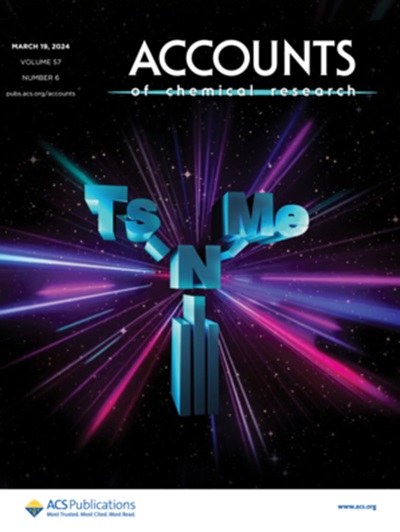Hydrogen Atom Transfer Promoted by Carbon-Centered Biradicals via Energy Transfer Catalysis
IF 16.4
1区 化学
Q1 CHEMISTRY, MULTIDISCIPLINARY
引用次数: 0
Abstract
In the past decade, visible-light-mediated photocatalysis has emerged as an applicable strategy for the generation of diverse radical species via single electron transfer (SET) and energy transfer (EnT) processes. Within this context, visible-light-mediated hydrogen atom transfer (HAT) has attracted major interest due to its mild and environmentally benign conditions applied in the selective activation of C–H bonds. Strategies employing C- and heteroatom-centered radical species to selectively activate C–H bonds have become versatile tools due to their mildness and good functional group compatibility for synthesizing value-added products. In this regard, a review on C-centered radical-promoted HAT processes was reported by Gevorgyan’s group ( Chem. Sci. 2020, 11, 12974, DOI: 10.1039/d0sc04881j), and a review on visible-light-promoted remote C–H functionalization via 1,5-HAT was recently reported by Zhu’s group ( Chem. Soc. Rev. 2021, 50, 7359, DOI: 10.1039/d0cs00774a). Compared to N- and O-centered radical-promoted HAT processes, C(sp3)-centered radical-promoted HAT is more challenging and less explored due to the small differences in C–H bond dissociation energies. Additionally, in the realm of C-centered radical-promoted HAT, the generation of C-centered radicals has mostly involved SET processes, while the EnT-mediated C-centered radical-promoted HAT process has been less discussed because of the considerable scarcity of related reports.

碳中心双自由基通过能量转移催化促进氢原子转移
在过去的十年中,可见光介导的光催化已经成为通过单电子转移(SET)和能量转移(EnT)过程产生多种自由基的一种适用策略。在此背景下,可见光介导的氢原子转移(HAT)由于其温和和环境友好的条件应用于C-H键的选择性激活而引起了人们的极大兴趣。利用以C和杂原子为中心的自由基选择性激活C- h键的策略由于其温和性和良好的官能团相容性而成为合成增值产品的通用工具。在这方面,Gevorgyan的小组(Chem。science . 2020, 11, 12974, DOI: 10.1039/d0sc04881j),并且Zhu的小组最近报道了可见光促进的1,5- hat远程C-H功能化的综述。Soc。Rev. 2021, 50,7359, DOI: 10.1039/d0cs00774a)。与N-中心和o -中心自由基促进的HAT过程相比,C(sp3)中心自由基促进的HAT过程更具挑战性,由于C - h键离解能差异较小,因此研究较少。此外,在c中心自由基促进的HAT领域,c中心自由基的产生主要涉及SET过程,而ent介导的c中心自由基促进的HAT过程由于相关报道相当缺乏而较少讨论。
本文章由计算机程序翻译,如有差异,请以英文原文为准。
求助全文
约1分钟内获得全文
求助全文
来源期刊

Accounts of Chemical Research
化学-化学综合
CiteScore
31.40
自引率
1.10%
发文量
312
审稿时长
2 months
期刊介绍:
Accounts of Chemical Research presents short, concise and critical articles offering easy-to-read overviews of basic research and applications in all areas of chemistry and biochemistry. These short reviews focus on research from the author’s own laboratory and are designed to teach the reader about a research project. In addition, Accounts of Chemical Research publishes commentaries that give an informed opinion on a current research problem. Special Issues online are devoted to a single topic of unusual activity and significance.
Accounts of Chemical Research replaces the traditional article abstract with an article "Conspectus." These entries synopsize the research affording the reader a closer look at the content and significance of an article. Through this provision of a more detailed description of the article contents, the Conspectus enhances the article's discoverability by search engines and the exposure for the research.
 求助内容:
求助内容: 应助结果提醒方式:
应助结果提醒方式:


